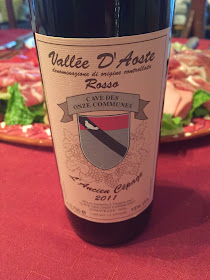I
previously wrote about my travels to the stunning Valle d'Aosta when
I wrote about the agriturismo, La
Viggni de Crest, that I stayed last October. They also produce their
own grapes that they sell off to a local cooperative. The cooperative,
Cave des Onze Communes, gathers the grapes they purchase from 11
different municipalities to produce a variety of wines. They produce
about 33,500 bottles from 19 different DOC wines under the only DOC
of the Aosta Valley, Valle d'Aosta DOC.
Cave des Onze Communes in the Valle Centrale
Cave des Onze Communes is located in Aymavilles, just outside the city center of Aosta in the central valley, Valle Centrale, where most of the winemaking of the region takes place. This region is not only the smallest in size, but also produces the least amount of wine throughout all of Italy, but it sure offers plenty of unique varietals.
Cave des Onze Communes in the Valle Centrale
Cave des Onze Communes is located in Aymavilles, just outside the city center of Aosta in the central valley, Valle Centrale, where most of the winemaking of the region takes place. This region is not only the smallest in size, but also produces the least amount of wine throughout all of Italy, but it sure offers plenty of unique varietals.
For
Christmas I typically will open some of my better bottles, but with hopes of 2015 bringing about my first child and knowing
that if that is the case, my wines will have to sit and not be drunk during this time frame. I figured I would let my older bottles
that I brought back from Italy rest since I know they will continue to age well. (Yes lots of thought went into that. We are talking wine here so it's important!) So I decided to open a bottle I brought back from my visit to the
Aosta Valley, which was the 2011 Cave des Onze Communes L'Ancien
Cepage. It's a red blend with grapes typical of this region
including petit rouge, fumin and mayolet.
The unique grapes of the Valle d'Aosta
Since this isn't a region that is on the top of everyone's list for visiting, unless you are the outdoors type or a big skier, I wanted to talk about some of the unknown grapes of the Aosta Valley. The natural beauty of the steep sloped vineyards and alps hanging over the valley is a memorable experience. What I found interesting were the large variety of grapes that were unfamiliar to me to such as the ones that are blended in this particular wine.
The unique grapes of the Valle d'Aosta
Since this isn't a region that is on the top of everyone's list for visiting, unless you are the outdoors type or a big skier, I wanted to talk about some of the unknown grapes of the Aosta Valley. The natural beauty of the steep sloped vineyards and alps hanging over the valley is a memorable experience. What I found interesting were the large variety of grapes that were unfamiliar to me to such as the ones that are blended in this particular wine.
About 75% of the wine produced from the Valle d'Aosta wine region are red wines with the red grape, Petit Rouge leading the way. This grape can be found in the wines of the subzones of the central valley including Enfer d'Arvier, Nus, Torrette and Chambave. Vino Italiano, by Joe Bastianich and David Lynch, compare the Fumin grape to a Cotes-du-Rhone Syrah. Mayolet is probably the least common of these three native grapes and is usually used as a blending grape. Over the years of winemaking in the Aosta Valley, this grape has slowly been replaced with other grapes due to the difficulty it takes to grow it.
I
hope one day you have the opportunity to try some of these native
grapes. Having the opportunity to taste wines that are indigenous of
a region is a true way to experience the terroir of that area.


No comments:
Post a Comment